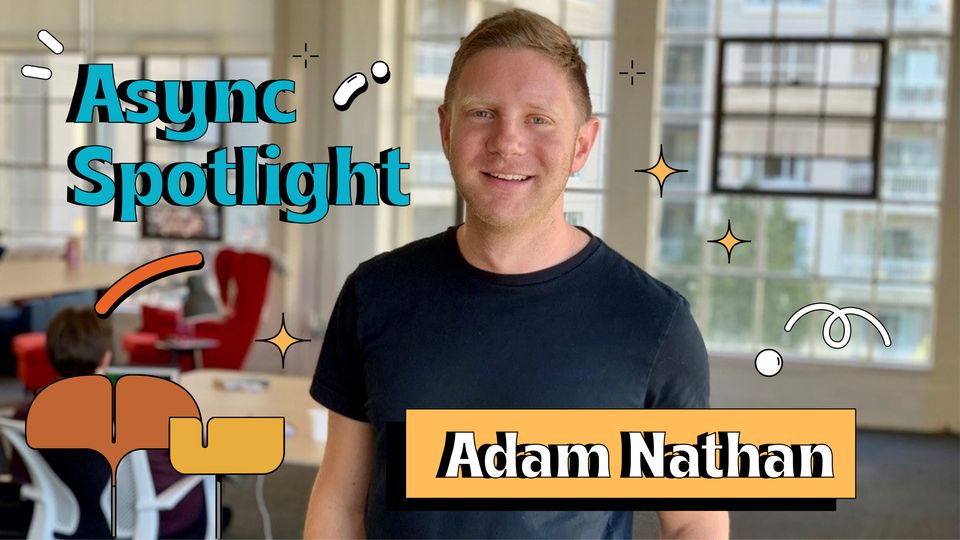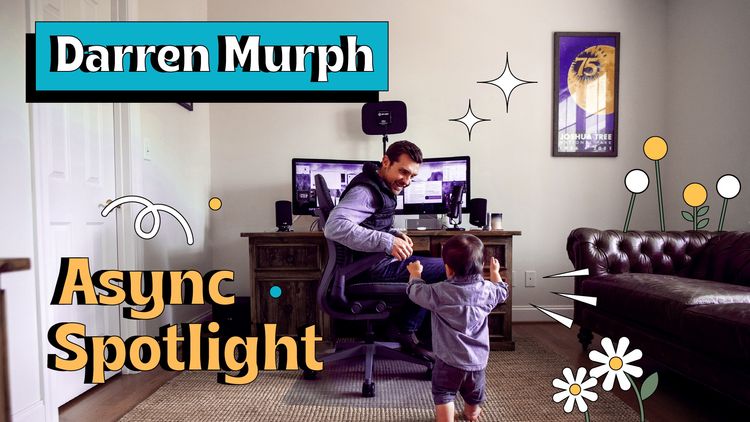How Almanac's CEO works async

The latest in our Async Leadership Spotlight series features Adam Nathan, the founder and CEO of Alamanac.
From the White House to Hawaiian Airlines to the company he founded four years ago, Adam has made a career out of helping teams wrangle the "process chaos" so they can focus on the things that really matter.
Under Adam's leadership, Almanac's team truly walks the walk when it comes to async. (Their product also happens to be our top pick for an async documentation tool.)
The most incredible thing I learned from this spotlight was that Adam's entire remote work setup is literally just his laptop. I didn't even know that was possible.
Enjoy and see you next time,
Becky and the Twist team
Name: Adam Nathan
Location: San Francisco
Title: CEO + Founder of Almanac
Company: Almanac
Number of employees: ~50
From how many countries: 14
Across how many time zones: 7
Social media: @adampnathan give me a follow!
Hello! Tell us a bit about yourself
As Almanac's cofounder, my job is to help people work better together on the internet.
Our mission is to help people spend their days doing work they wake up in the morning to do, the work that only they can do—instead of manually managing tasks that should be lightning-fast with today's tooling.
Our company, Almanac, is an all-in-one platform for integrating and automating work that happens in documents so your team can get to faster, better decisions without meetings.
How did you end up where you are in your career?
My educational background is in systems engineering, and I spent the first part of my career working in large, complex organizations to help them run more efficiently at The White House, The Bridgespan Group, and Hawaiian Airlines. I observed first-hand how great processes can either empower teams or constrain them.
After business school, I started working in tech—and was surprised to see that despite a supposedly more powerful toolset, the way work happened across both tech startups and large companies like Apple was just as dysfunctional as old "analog" companies.
However, this process chaos wasn't evenly distributed; some teams like engineers and designers had tools like Github and Figma to automate their work.
But, for managers like me, there was no platform to automate simple tasks, integrate the steps of my workflow into a single place, and let me focus on the creative parts of my job.
Because of this lack of tooling, I spent hundreds of hours trying to answer basic questions: did my team read the doc I sent? What did they think of my new idea? Did my boss sign off on my proposal?
Thanks to the internet, these simple questions should be answered in seconds. Instead, they were taking all my time.
This wasn't a problem that just affected me—it was preventing hundreds of thousands of managers from doing their actual jobs. And so I founded Almanac to solve it.
How did you first learn about/start practicing async-first work?
We have been a distributed company from Day One.
Back when we started Almanac, we realized it was crazy to only hire in San Francisco.
We were a small, cash-constrained startup, and there was a ton of amazing talent across the world that could help us build the product and company we wanted.
As we hired our team across the world, we quickly realized that we needed to transition to a more asynchronous way of working to be effective across geographies and time zones.
More importantly, at Almanac we're building a product that supports and embeds async practices into work. Almanac reinforces core async principles by allowing teams to make decisions without meetings.
What does a typical workday look like for you?
6:45: Wake up, ground and brew fresh coffee, and complete some Review Requests in Almanac sent the night before
7-8: Gym time- I'm at regular at Crossfit and Barry's.
8-9: Standup meetings across our global Almanac team.
9-10: 1:1s with co-workers in Europe.
10-3: Focus time for deep work
3-6: Sales demos, new customer onboardings, and employee interviews
6-7: Read or bike down to the beach
7: Cook at home and tech-free dinner with my partner
8-10: Complete some more async work in Almanac
10-11: Finish the night with a fun TV show!
How would you describe async collaboration to someone unfamiliar with the concept?
A way to make decisions without meetings!
What’s the biggest benefit your company gets from working async-first?
The biggest benefit of async is that it enables effective remote work, which means having the privilege to collaborate with a team of uncommonly smart and kind people from around the world.
Async allows us to aggregate a diversity of ideas, perspectives, and working styles in a way we could not if we were hiring solely in one city.
Async-first work also provides a culture of focus, flow and near-constant progress (24/5!) where decisions can be made faster with more transparency, clarity, and inclusivity.
What’s the biggest benefit you personally get from working async-first?
It's simple: I get more done with fewer meetings. Async-first work allows me to be more productive than I have ever been.
Biggest challenge of working asynchronously? How have you and your team overcome (or tried to overcome) it?
I'm an extrovert and get energy from other people, so I miss the social aspect of the office. To mitigate this, I spend more time working in local coffee shops, going out to pick up lunch, and spending more time with my friends and family.

One piece of advice for team leaders who want to create a more async culture on their team:
Lead from the front. If you want to create an async team, be the example by writing things down yourself, canceling unnecessary meetings, and asking people to submit async reviews of their work in a tool like Almanac. You can't expect people to work async if you don't live it yourself.
Time you typically spend in meetings per week:
10-15 hours. It depends on the week!
Favorite way to say no to a meeting…
I ask: "Did you submit a review request of this in Almanac?" 😁
Favorite virtual team bonding activity…
We start off most meetings with fun kick-off questions and it’s a nice way to connect as humans.
How do you like to recharge or take a break?
I love biking down to the beach, tending to my plants, working on side projects (nonprofit boards are a very gratifying use of time!), working out, and spending time with my partner.
Best home office upgrade you’ve ever made…
I just use my laptop. I'm a remote work heathen. Send recs please!

Something that’s changed the way you approach work/life…
The best thing you can do when things get stressful or frustrating is take a break. Get up, look out the window, go for a walk—do anything to create some perspective.
More on how Almanac collaborates asynchronously…
Home Page
Demo Page
Templates
Fall Release
Our Blog



